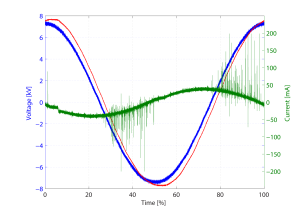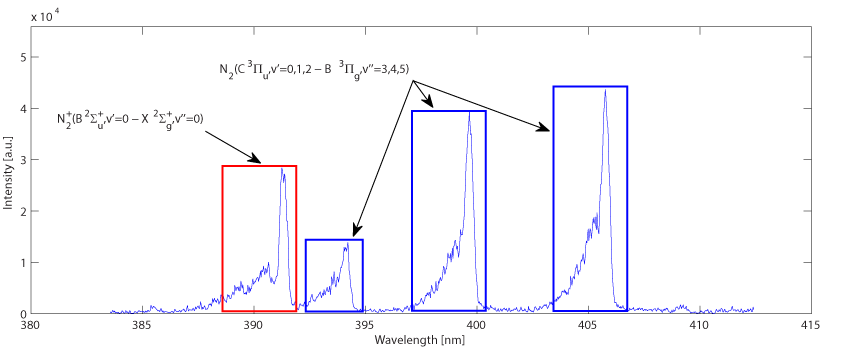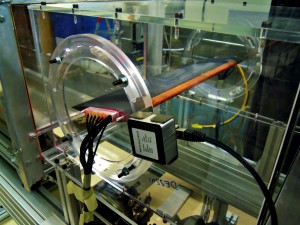An experimental study on plasma characteristics
Active flow control by the use of dielectric barrier discharge (DBD) plasma actuators has been proven to be a promising concept for the delay and even elimination of boundary layer separation. Both the simplicity of the system as well as the potential for flow and even flight control make plasma actuators increasingly interesting for research in aerodynamics worldwide.
Plasma actuators for flow control
In the past few years, the term plasma actuator has made its entry into the aerodynamics’ flow control jargon. In this field, two different types of dielectric barrier discharge actuators are currently investigated. Alternating current (AC-DBD) and nanosecond pulsed direct current (ns-DBD) plasmas differ in terms of input voltage signal. Consequently, the main flow control working mechanism of both discharges is distinct. Where the AC-DBD working principle is related to an increase of momentum in the boundary layer, well known as a wall-jet, the ns-DBD is assumed to operate on a thermal effect. The rapid localized adiabatic heating of the near-surface gas creates compression waves that emerge from the surface, adding pulsed energy to the flow.
A dielectric barrier discharge is an electrical discharge between two electrodes that are separated by a dielectric layer. When the electric field between the electrodes is increased, free charge carriers in the gas are accelerated towards the electrodes. These charge carriers will undergo inelastic collisions with molecules that are present in the gas, leaving these molecules in a specific excited energy state. This process is known as gas ionisation. Further increasing the potential between the electrodes will lead to plasma streamers on the dielectric surface.
Experimental plasma characterization
In order to develop safer and more efficient applications of DBD actuators, a better understanding of the plasma state and behaviour under different operating conditions is needed. The thesis work presented here consisted of a thorough investigation of the plasma characteristics of AC-DBD and ns-DBD under different operating conditions such as voltage amplitude, ambient pressure and dielectric thickness. The relevance of this research relates to real-life applications of DBD devices for active flow control on aircraft. During take-off, the ambient pressure is nearly five times as high compared to the pressure at cruise altitude, where the plasma behaves differently.
Electrical measurements of voltage and current signals reveal information about the strength and duration of the plasma streamers. Phase-locked fast-camera plasma imaging shows the temporal and spatial evolution of the plasma in the electrode gap. The most interesting plasma diagnostics technique used is optical emission spectroscopy, which allows the unambiguous identification of excited species in the plasma sheet. Molecular excitations are created in the plasma by electron impact processes and de-excite by molecular collisions or radiative decay, thereby emitting a photon. The wavelength of the light that is emitted during this de-excitation corresponds to a unique excited state.

Electrical measurements
Electrical measurements of the current signal on an AC-DBD actuator are shown in Figure 1. The current, represented by the green line, consists of capacitive current and current disturbances due to the presence of plasma. Two plasma streamers are present in one voltage cycle, respectively during rise and fall time of the voltage. The strength, duration and timing of the streamers are retrieved from these measurements (Geuns, 2014). Similarly, plasma streamers are only present during the (very short) ascending and descending phases of the voltage pulse in ns-DBD. The time in which plasma streamers are present in this case only equals several nanoseconds. Even though power peaks up to 200kW are noticed, the average power consumption of the actuator is found to be low (about 5W).
Optical emission spectroscopy
By analyzing light emission from the plasma, the molecular excitations that are present in the gas can be determined. Figure 2 shows a measured spectrum at the 380nm to 415nm wavelength range, involving transitions of nitrogen and N2+ ground state molecules. A higher peak in the emission spectrum indicates a higher intensity and thus a higher population density of the corresponding excited state. The amount of molecular excitations directly relates to the degree of ionization and consequently the strength of the plasma.

As can be seen from Figure 3, the amount of excites species in the plasma decreases with rising ambient pressure. The plasma appears to be stronger and brighter at lower pressures when all other parameters are constant. Having fewer molecules in air at lower pressures, the mean free path and energy gain of the free electrons increases, thereby increasing the likelihood of transition during electron impact collisions. Similar downward trends of excited species are measured with increasing dielectric thickness and decreasing voltage amplitude. Here, the measured trends can be related to the strength of the electric field between the electrodes. A higher electric field (higher voltage, smaller distance) leads to a faster acceleration of the free charge carriers. The plasma strength and composition highly depend on the operating conditions.

Wind tunnel experiments

The influence of voltage amplitude and pulsing frequency on flow separation control are investigated on a NACA 0015 profile with an integrated leading edge ns-DBD actuator in a low-speed wind tunnel (Figure 4). Results indicate the existence of an optimal dimensionless frequency of about two. Consequently, the optimal pulsing frequency is directly related to the flow speed, but remains rather low. Large zones of vorticity are observed over the airfoil at these low frequencies, which are ensuring flow reattachment. At higher frequencies, the vorticity zones are much smaller, having less influence on the flow behaviour.
Also, a voltage threshold seems to exist which is dependent on the angle of attack of the profile. As soon as plasma is present between the electrodes, an effect on the pressure distribution around the airfoil can be seen. However, more energy needs to be transferred into the flow in order to achieve full reattachment at higher angles of attack.
Areas of research
The use of plasma actuators as active flow control devices has been widely investigated during the last decade. The potential is enormous, and results are promising. Separation postponement, lift enhancement, drag reduction and laminar-turbulent transition control pave the way to more sustainable flow and even flight control. Also in the internal flow domain, plasma actuators are currently being investigated. The presence of excited atoms and molecules in the plasma, the ultra-fast local heating of the gas and the creation of ozone molecules opens perspectives for so-called Plasma Assisted Combustion (PAC) in modern engines.
by Rik Geuns, MSc Graduate Aerospace Engineering (MSc thesis at Ecole Polytechnique Fédérale de Lausanne, Switzerand)
References:
- Geuns, S. Goekce, G. Plyushchev and P. Leyland. Understanding SDBD actuators: An Experimental Study on Plasma Characteristics, 45th Plasmadynamics and Lasers Conference, Atlanta, June 2014.
